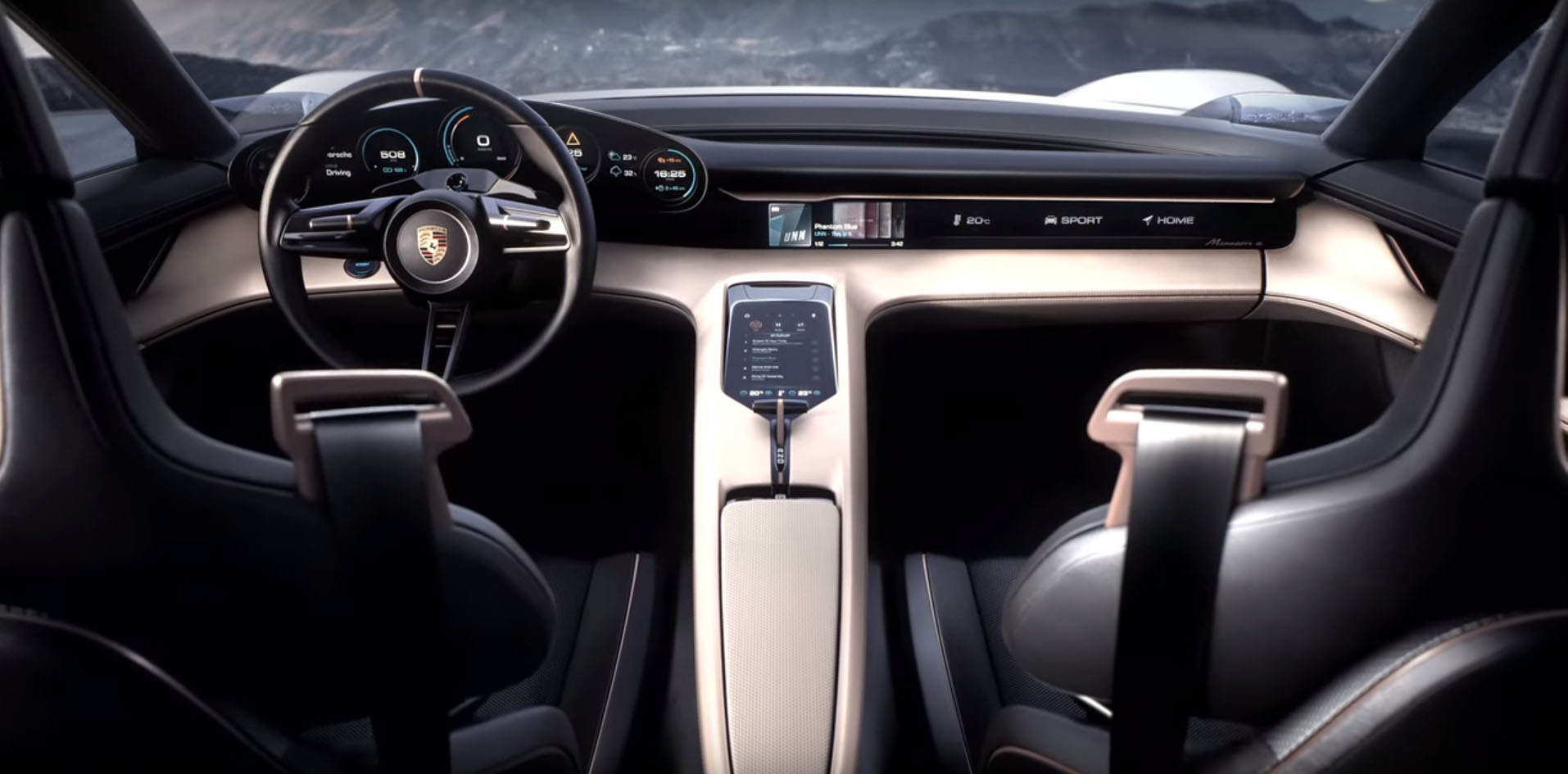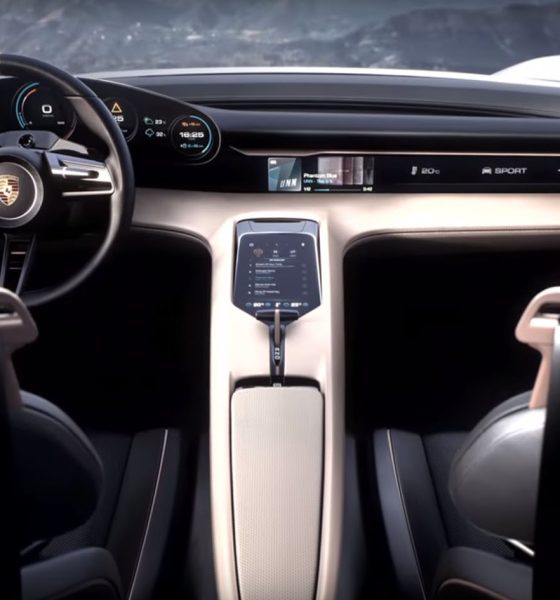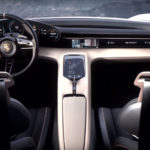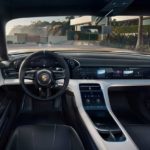

News
Porsche Taycan interior shows prototype’s steering wheel buttons, digital instrument cluster
Porsche has several camouflaged Taycan prototypes doing real-world tests across the globe. Earlier this month, one was spotted charging at a CCS station in Germany, and not long after that, another prototype was spotted track testing at the Nurburgring. Even more recently, two camouflaged Taycan test units were photographed in Christchurch, New Zealand, providing what could very well be the closest look yet at the test vehicles’ interior.
The images of the Taycan prototypes’ interior were shared on Facebook by Tesla Model S owner and Taycan reservation holder Jim Roger Johansen and car enthusiast Michael McDonald. The pictures of the camouflaged Taycan’s interior include provisional elements such as a large, landscape-oriented display at the center of the dashboard, as well as fully-covered door panels and seats. That said, what is visible in the image is quite compelling.
(Update: The images were removed as per request of the owner of the location where the Taycan prototypes were being stored.)
Immediately noticeable from the recently shared pictures is the vehicle’s instrument cluster, which is made up of just one large screen, similar to that of the Tesla Model S. The rather expansive instrument cluster also appears to be taken directly from the Mission E sedan concept car that Porsche unveiled back in 2015 at the Frankfurt Motor Show as well. Also prominent in the camouflaged Taycan interior shots is a steering wheel that features a healthy amount of buttons and a pair of Model 3-esque scroll wheels. Overall, the steering wheel of the Taycan prototypes looked very similar to the steering wheel of the Mission E Cross Turismo concept, save for the latter’s Sport Response knob, which controls the vehicle’s driving modes.
The combination of the prototype’s clean, sleek digital instrument cluster and its button-filled steering wheel invokes an effect that is very characteristic of Porsche. The company, after all, has an almost notorious reputation for going a bit overboard with the buttons on its vehicles. The Porsche Panamera for one, almost became a meme due to the legacy automaker’s decision to cram a whopping 44 buttons and switches on the vehicle’s center console alone. Other models such as the Cayenne and the Macan also adopted the same button-heavy theme.
- The interior of the Porsche Mission E sedan concept. [Credit: Porsche]
- The interior of the Porsche Mission E Cross Turismo concept. [Credit: Porsche]
Porsche is aiming to start production of the Taycan (formerly known as the Mission E sedan), sometime next year. Despite production expected to be a year or so away, the German automaker has already started accepting pre-orders for the vehicle. In the United States alone, Porsche is offering a Deposit Option Program, which allows customers to pre-order the electric car. Porsche Managing Director Alexander Pollich also noted that the Taycan is garnering a strong, positive reception from customers so far.
The Taycan is expected to feature Porsche’s trademark performance. The vehicle is listed with a 0-60 mph time of 3.5 seconds, a range of 310 miles per charge, and a top speed of 155 mph. The electric car is expected to be produced at Porsche’s facility in Stuttgart, Germany, where the company produces vehicles like the 911, 718 Boxster, and the 718 Cayman. The legacy automaker is expecting to produce 20,000 units of the Taycan annually when the electric car enters production.

Elon Musk
Elon Musk’s X will start using a Tesla-like software update strategy
The initiative seems designed to accelerate updates to the social media platform, while maintaining maximum transparency.

Elon Musk’s social media platform X will adopt a Tesla-esque approach to software updates for its algorithm.
The initiative seems designed to accelerate updates to the social media platform, while maintaining maximum transparency.
X’s updates to its updates
As per Musk in a post on X, the social media company will be making a new algorithm to determine what organic and advertising posts are recommended to users. These updates would then be repeated every four weeks.
“We will make the new 𝕏 algorithm, including all code used to determine what organic and advertising posts are recommended to users, open source in 7 days. This will be repeated every 4 weeks, with comprehensive developer notes, to help you understand what changed,” Musk wrote in his post.
The initiative somewhat mirrors Tesla’s over-the-air update model, where vehicle software is regularly refined and pushed to users with detailed release notes. This should allow users to better understand the details of X’s every update and foster a healthy feedback loop for the social media platform.
xAI and X
X, formerly Twitter, has been acquired by Elon Musk’s artificial intelligence startup, xAI last year. Since then, xAI has seen a rapid rise in valuation. Following the company’s the company’s upsized $20 billion Series E funding round, estimates now suggest that xAI is worth tens about $230 to $235 billion. That’s several times larger than Tesla when Elon Musk received his controversial 2018 CEO Performance Award.
As per xAI, the Series E funding round attracted a diverse group of investors, including Valor Equity Partners, Stepstone Group, Fidelity Management & Research Company, Qatar Investment Authority, MGX, and Baron Capital Group, among others. Strategic partners NVIDIA and Cisco Investments also continued support for building the world’s largest GPU clusters.
News
Tesla FSD Supervised wins MotorTrend’s Best Driver Assistance Award
The decision marks a notable reversal for the publication from prior years, with judges citing major real-world improvements that pushed Tesla’s latest FSD software ahead of every competing ADAS system.

Tesla’s Full Self-Driving (Supervised) system has been named the best driver-assistance technology on the market, earning top honors at the 2026 MotorTrend Best Tech Awards.
The decision marks a notable reversal for the publication from prior years, with judges citing major real-world improvements that pushed Tesla’s latest FSD software ahead of every competing ADAS system. And it wasn’t even close.
MotorTrend reverses course
MotorTrend awarded Tesla FSD (Supervised) its 2026 Best Tech Driver Assistance title after extensive testing of the latest v14 software. The publication acknowledged that it had previously criticized earlier versions of FSD for erratic behavior and near-miss incidents, ultimately favoring rivals such as GM’s Super Cruise in earlier evaluations.
According to MotorTrend, the newest iteration of FSD resolved many of those shortcomings. Testers said v14 showed far smoother behavior in complex urban scenarios, including unprotected left turns, traffic circles, emergency vehicles, and dense city streets. While the system still requires constant driver supervision, judges concluded that no other advanced driver-assistance system currently matches its breadth of capability.
Unlike rival systems that rely on combinations of cameras, radar, lidar, and mapped highways, Tesla’s FSD operates using a camera-only approach and is capable of driving on city streets, rural roads, and freeways. MotorTrend stated that pure utility, the ability to handle nearly all road types, ultimately separated FSD from competitors like Ford BlueCruise, GM Super Cruise, and BMW’s Highway Assistant.
High cost and high capability
MotorTrend also addressed FSD’s pricing, which remains significantly higher than rival systems. Tesla currently charges $8,000 for a one-time purchase or $99 per month for a subscription, compared with far lower upfront and subscription costs from other automakers. The publication noted that the premium is justified given FSD’s unmatched scope and continuous software evolution.
Safety remained a central focus of the evaluation. While testers reported collision-free operation over thousands of miles, they noted ongoing concerns around FSD’s configurable driving modes, including options that allow aggressive driving and speeds beyond posted limits. MotorTrend emphasized that, like all Level 2 systems, FSD still depends on a fully attentive human driver at all times.
Despite those caveats, the publication concluded that Tesla’s rapid software progress fundamentally reshaped the competitive landscape. For drivers seeking the most capable hands-on driver-assistance system available today, MotorTrend concluded Tesla FSD (Supervised) now stands alone at the top.
News
Elon Musk’s Grokipedia surges to 5.6M articles, almost 79% of English Wikipedia
The explosive growth marks a major milestone for the AI-powered online encyclopedia, which was launched by Elon Musk’s xAI just months ago.

Elon Musk’s Grokipedia has grown to an impressive 5,615,201 articles as of today, closing in on 79% of the English Wikipedia’s current total of 7,119,376 articles.
The explosive growth marks a major milestone for the AI-powered online encyclopedia, which was launched by Elon Musk’s xAI just months ago. Needless to say, it would only be a matter of time before Grokipedia exceeds English Wikipedia in sheer volume.
Grokipedia’s rapid growth
xAI’s vision for Grokipedia emphasizes neutrality, while Grok’s reasoning capabilities allow for fast drafting and fact-checking. When Elon Musk announced the initiative in late September 2025, he noted that Grokipedia would be an improvement to Wikipedia because it would be designed to avoid bias.
At the time, Musk noted that Grokipedia “is a necessary step towards the xAI goal of understanding the Universe.”
Grokipedia was launched in late October, and while xAI was careful to list it only as Version 0.1 at the time, the online encyclopedia immediately earned praise. Wikipedia co-founder Larry Sanger highlighted the project’s innovative approach, noting how it leverages AI to fill knowledge gaps and enable rapid updates. Netizens also observed how Grokipedia tends to present articles in a more objective manner compared to Wikipedia, which is edited by humans.
Elon Musk’s ambitious plans
With 5,615,201 total articles, Grokipedia has now grown to almost 79% of English Wikipedia’s article base. This is incredibly quick, though Grokipedia remains text-only for now. xAI, for its part, has now updated the online encyclopedia’s iteration to v0.2.
Elon Musk has shared bold ideas for Grokipedia, including sending a record of the entire knowledge base to space as part of xAI’s mission to preserve and expand human understanding. At some point, Musk stated that Grokipedia will be renamed to Encyclopedia Galactica, and it will be sent to the cosmos.
“When Grokipedia is good enough (long way to go), we will change the name to Encyclopedia Galactica. It will be an open source distillation of all knowledge, including audio, images and video. Join xAI to help build the sci-fi version of the Library of Alexandria!” Musk wrote, adding in a later post that “Copies will be etched in stone and sent to the Moon, Mars and beyond. This time, it will not be lost.”










